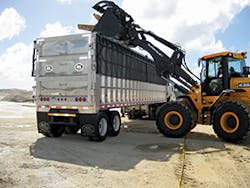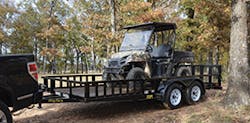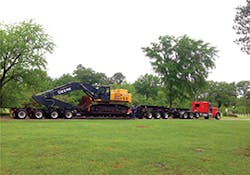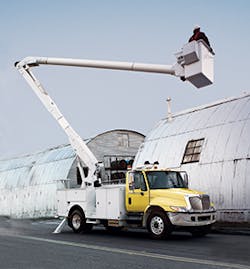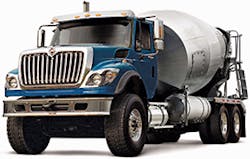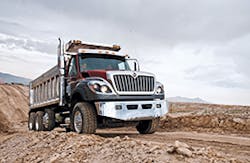The trailers from Big Tex Trailers all have a gross vehicle weight rating (GVWR) that is based on the size of the axle or axles used and the total weight of the trailer, says company spokesperson Tammy Foster. “This determines the weight the trailer can transport safely and efficiently. The dumps also have a payload that states how much they can handle and operate safely in the dump,” she says.
Felton Norris owns Nutex Transport in San Antonio, TX, transporting everything from small slabs to large cranes. His company does a lot of work for rental companies such as United Rentals and Equipment Depot.
Norris uses XL Specialized Trailers, mainly the XL 110 low-profile hydraulic detachable gooseneck, which hauls 55 tons and is favored by contractors seeking to haul medium-duty equipment and heavy-duty loads.
Norris also has the XL 130 low-profile hydraulic detachable gooseneck, which hauls 65 tons. “It’s a good, easy-pulling trailer,” he says. “I don’t have any problems with it.”
Norris points out that the gross weight of the unit dictates how he will spec a trailer.
Recently, his company hauled a crane, which meant Norris had to figure in its weight minus the truck and trailer weight. “That determines how many axles you’re going to need to transport that piece of equipment,” he points out.
Norris will spec a stinger bar for heavy weight hauls. Another prime concern for him is flooring. “You need a wider trailer for some of these hauls,” he says, adding he recently ordered a new trailer that is 9 feet wide, enabling him to drive up on it and be able to haul rubber-tracked excavators that are certain to stay on the trailer rather than hanging off of it.
Big Tex Trailers have a weight
rating that is based on the size of the axle and the total weight of the trailer.
Norris favors air brakes in the trucks used to haul the trailer. “As equipment gets heavier, exceeding 55 tons, it generally becomes more varied and therefore requires a more specialized trailer,” notes Rodney Crim, director of sales, adding that custom-engineered trailers will ensure the spec that will work best for the required loads in tandem with the truck.
Rogers Brothers Corp. manufacturers several different types of trailers, ranging from the small drawbar Tag-Along series that typically are pulled behind a dump truck and used to carry 20 to 25 tons, such as a small- to medium-size excavator, to the company’s specialized series.
The company’s fixed gooseneck trailer’s capacity is 25 to 35 tons. They are rear-load types of trailers for loading and unloading different pieces of equipment that serve the market of those who prefer such trailers, says Jay Kulyk, the company’s president, adding that the company builds custom models of the style up to 50-ton capacity and beyond.
Rogers Brothers also manufactures detachable gooseneck trailers with a capacity range of 35 tons to in excess of 100 tons. “You detach the gooseneck, it stays with the truck, and you pull that away so you can load or unload equipment over the front of the trailer,” says Kulyk, adding that some pieces of equipment require loading ramps.
“The idea is you separate the gooseneck from the frame of the trailer and then that opens up the front of the trailer as a loading surface to access the deck of the trailer,” he says.
That’s the most common method of loading and unloading, Kulyk says. “Front-loading gives you the least amount of load angle, which for many machines is very important,” he says. “It’s a safer and more stable way to load than over the rear of the trailer that involves a climb of 30 or more inches. Loading over the front, you would climb 12 or 15 inches at a much less of an angle than you would over the ramps of the rear of the trailer.”
The company’s Ultima and Century series detachable gooseneck lowbed trailers are two variations of the same capability, according to Kulyk.
“The Ultima Series is designed with a more heavy-duty specification to handle higher concentrated loads under the most challenging operating conditions,” says Kulyk. “They are more durable of a product line and cost a little more for that reason.”
The 35-, 50-, and 55-ton models are designed with a half-deck length load concentration and manufactured with 100,000 minimum yield steel. “The Century Series was designed to provide the basics to the marketplace to minimize the weight and maximize the value and the economy of that trailer,” Kulyk adds. “It doesn’t have all of the same options and accessories available as the Ultima series does.”
Described by the company as a “no-frills group of detachable gooseneck lowboy trailers,” the Century Series features a two-thirds deck load concentration and is designed to haul a variety of loads. The series is constructed of 100,000-yield steel.
Both trailers are used interchangeably, Kulyk says.
Rogers Brothers’ Specialized Series provides customized trailers for those
who need something not offered in the company’s predesigned lineup.
The Blacktop Series from Rogers Brothers includes the Gentle Riser, which has a low, level deck and a 16-degree incline riser to the rear frame. The Gentle Riser is available in 35- to 60-ton capacities. The Sloper features a continuous five-degree incline up the length of the deck and is available in a 35-ton model.
“Blacktop Series trailers are particularly useful for customers who have paving types of equipment,” says Kulyk. “They are designed to allow the entire length of the trailer behind the gooseneck to be used as load surface, providing easier access to the area over the trailer’s rear frame.”
The additional loading space provides for multiple pieces of equipment. Kulyk says the trailer has been favored over the past several years for its flexibility.
“The idea is to more easily open up the entire length of the trailer for hauling,” he says. “While other trailers are capable of having machinery loaded up over the back, it’s a steeper climb and not all types of equipment can handle that transition.”
Rogers Brothers’ Specialized Series provides customized trailers for those who need something not offered in the company’s predesigned lineup.
“Oftentimes, it’s a longer or shorter deck length, while other times we go from a standard width trailer-which in most cases is 8 feet, 6 inches-and go to nine or 10 feet wide because an end user has specific machinery which requires that size,” Kulyk says.
Rogers Brothers also offers different deck styles, including a drop side deck trailer. “Instead of the platform deck being at the height of the main carrying beams, we drop the deck height to the outside of the main carrying beams to get as much overhead clearance for tall machinery as possible,” says Kulyk.
“We provide a loading surface that is as low as 14 inches from the ground whereas a typical platform deck runs to 20 and in some cases up to 24 inches off of the ground,” he adds. “For taller machines, six or seven inches can make a lot of difference.”
When it comes to pairing the trailer to a truck, “it’s very important when buying lowboys to know the characteristics of the truck,” Kulyk points out. “Swing clearance dimensions are critical. If you don’t have thorough information on a custom trailer when you’re designing it, you can create a situation where the gooseneck won’t operate properly with the truck that the company owns. That’s particularly important when you’re building a higher-capacity custom trailer.”
Smaller trailers, such as those in the 35-ton range, typically fall into more standard dimensioning, so there’s less likelihood of a compatibility issue with whichever truck a contractor is using, he adds.
For trailers with more than 50-ton capacities, contractors are asked to complete paperwork that outlines dimensions to ensure proper compatibility, says Kulyk.
“Another issue owners need to be aware of is how weight is distributed from the trailer onto their truck and how that truck is configured to handle that weight,” he says. “There’s a variety of specifications available on trucks as far as the carrying capacity, particularly the rear of the drive axles of the truck.”
A bucket boom swings into action.
Lowboys tend to impart more weight on the truck than other types of trailers, so it’s important to know what a truck is capable of hauling when specifying out a lowboy, Kulyk says.
“Trailers with a 60-ton and higher capacity distribute a significant amount of weight to the truck through the trailer’s gooseneck, and if the truck can’t handle it, you have to add a jeep dolly,” he says. “Its function is to help redistribute weight to more axles so that the truck will not be overloaded and the trailer can still be loaded to its capacity.”
Kulyk points out there is “an entire regulatory set of circumstances for which each customer and owner needs to be aware. Each state has its own regulations to define load limitations by weight and/or dimensions. Loads that exceed these limits will likely require state-issued permits to legally be moved from location to location.”
Kulyk acknowledges it can be difficult to have a rig that’s legal in multiple jurisdictions, due to the differences in regulations from state to state.
Some states set limits on pounds per axle. Others require a certain axle spacing to meet guidelines. In some states, both factors apply.
“Oversize/overweight permits are a state-level issue, so there are no overriding federal standards,” Kulyk says. “Owners/operators need to be aware of their characteristics and where they work. One state may have entirely different rules and they need to be conscious of that when they’re specifying a particular design of a trailer because what may be perfectly legal in Pennsylvania may not be legal in Ohio.”
Terrain and road conditions are also considerations.
“It’s an important one for drivers to be aware of, because by definition the lowboy’s frame is very low to the ground and the driver runs the risk of grounding the trailer,” Kulyk says. “If you were to go over a hump in the road, the bottom of the trailer can make contact with the road, and that can be very bad. That’s the biggest risk at some older railroad crossings.”
The biggest difference between hauling compact equipment versus medium- to heavy-duty equipment is simply the size and weight, says Chris Pokornowski, national sales manager for Towmaster Trailers.
The majority of compact equipment is typically hauled on smaller payload trailers, he points out. “These trailers typically come with fenders and low ground clearance compared to the larger equipment,” Pokornowski says, adding that the most common Towmaster Trailers used by the compact equipment haulers are the TC-12D, T-12D, and the T-14D. These trailers have payload capacities of 12,000 and 14,000 pounds.
“The medium- to heavy-equipment trailers will typically use what we call a “˜deck over’ trailer,”
A Continental Mixer from
Navistar
Pokornowski says. “These trailers have a wider loading platform, since the deck is over the wheels. These trailers come in a payload range of 14,000 to 50,000 pounds with the most common Towmaster Trailers being the T-20 and T-40.”
One of the most common options added to the Towmaster T-40 is the Double Break Beavertail. It is designed to add an improved load angle, “which helps ease the minds of those loading and unloading equipment day in and day out,” Pokornowski says.
Contractors hauling nothing but heavy equipment tend to go with the Hydraulic Detachable Gooseneck trailers, Pokornowski says.
“These trailers come in a large array of capacities to pretty much suit any need,” he adds. “The nice feature about the detachable gooseneck trailers is that you can haul heavy equipment low to the ground. In most cases, equipment can be hauled only 20 to 24 inches off the ground.”
One of the most common hydraulic detachable gooseneck trailers used in the industry is the 110,000-pound capacity one, Pokornowski says. Towmaster offers the T-110DTG.
In Burnsville, MN, Tony Schueller is a truck driver for RDO Equipment, a John Deere dealership, where he hauls equipment on Towmaster trailers to contractors who are either buying or renting the equipment.
He moves equipment weighing from 9,000 to 80,000 pounds on a daily basis. Sometimes, the contractors will buy or rent the trailer along with the equipment. They’ll spec it for what they need.
“They know Towmasters and what they’re good for,” Schueller says.
It’s critical to partner a trailer with the right truck.
A Navistar Workstar covers ground.
When Navistar receives a request from a contractor for assistance to spec a truck that will be hauling equipment, the first order of business is to determine what they’re hauling, because that’s going to make the biggest determination as to how to spec the truck, according to Chad Semler, vocational marketing manager for Navistar.
“What we find happens occasionally is that someone orders a light-duty dump truck that’s a four by two and then later decides they want to try to pull a bulldozer with it, and it’s not ready to do that,” Semler says.
“You want to make sure you match the GCVW with the planned load,” he adds. “Once you know your target, then you can spec the proper engine for the horsepower and torque that you need to pull the load.”
The transmission is a matter of preference, Semler says. “That can make a big difference on how easy it is, depending on your terrain,” he says. “If you’re going to be on the road or off the road, that can affect your suspension. If you’re going to be off-road you’re going to want an off-road-rated suspension.”
In direct relation to that is gear ratio. “You can have various ratings with the same engine with varying gear ratios,” Semler says.
Another factor to consider in specifying a truck is whether the trailer is going to be towed by a bumper or a pencil hitch, Semler says. “You can even spec the pencil hitch right on the truck,” he says. “Or it could be a ball hitch or a gooseneck.”
Brakes can be either electric or air. “We have the option on the truck to have the proper electrical connector for electric brakes or the option to provide the glad hands for the air hookups for trailer air brakes at the rear of the vehicle as well,” Semler says.
Navistar’s Diamond Logic-a truck multiplexing system-assists with pretrip inspections. It is an onboard minicomputer with inputs and outputs that are programmable for user preferences, says Semler.
“Just like an over-the-road truck, you have to have a pretrip inspection,” he points out. “When your trailer lights are hooked up, you want to make sure they work just like your truck lights. The pre-trip inspection flashes lights so you can be out of the vehicle. The vehicle automatically flashes the lights and you can check off on your report that your lights are working.”
Another preference may be tied into safety factors, such as activating the lights when the windshield wipers are on. “There’s an automatic windshield wiper to slow if the vehicle is in neutral,” says Semler. “You can set a time, say 30 seconds, so that you’re not leaving your windshield wipers on high.”
The contractor also may prefer a setting where the sensors on the body control the truck movement in conjunction with the boom action.
The region of the country in which a contractor operates also plays a role in how a truck is specified, involving such factors as ground clearance and drive configuration.
“Out west, we see all-wheel drive a little bit more and even, to a certain extent, some crew cabs because they’re getting off road for longer periods of time and need extra people, such as in utility work and wildfires,” says Semler. “You never do these power lines alone, so there’s always a crew of people for safety requirements.”
Navistar’s trucks also are designed for driver comfort and safety. “We pride ourselves in our ingress and egress in getting in and out of the truck in the safest manner with three points of touch when you enter and exit,” says Semler, adding that the company also offers a full line of interior options, from the basic to the luxurious.
Semler points out there are three basic types of transmissions and each user generally has a preference. “It could be a fully automatic transmission, such as in most of our cars, which is well-suited for off-road and a lot of stop-and-start and makes a difference on the planned use of your truck,” he says.
Fully manual transmission is the most simple, economical type but requires more driver skill, Semler says.
The fully automated transmission is gaining traction, he adds. “An automated manual is basically a manual transmission, but the difference is, rather than using your foot to operate the clutch, that clutch operation is automated through solenoids in a computer,” Semler says. “The nice part about that is it’s a little bit more efficient than a fully automatic because you don’t have a torque converter constantly eating up a little parasitic energy and it also makes the manual transmission shift at the optimal point in the engine torque curve, so it’s very efficient. Those are available mostly in heavy-duty, but also in medium-duty products in our DuraStar line.”
That includes the heavy-duty diesel International WorkStar, which features Navistar’s 13-liter SCR-based engine and the Diamond Logic electrical system. Its wide-track axles are designed to provide maximum maneuverability and up to a 50-degree wheel cut. Its cooling system is mounted above frame rails to accommodate front-mounted PTO without a hole in the radiator to ensure maximum durability, cooling capacity, and ground clearance in on/off-highway environments.
It also features a double-sided galvanized steel cab for long-term corrosion protection and a high-visibility hood.
“That’s always very important for contractors driving off road or even in cities for to be able to see people in cars close in front of them,” points out Semler.
The International DuraStar’s options of MaxxForce7, MaxxForce DT, or MaxxForce 9 enable the operator to choose the desired engine capability.
The DuraStar also comes with a Diamond Logic electrical system. Its setback axle is designed for optimal maneuverability and a tight turning radius. It also features a sloped hood and swept-back, curved windshield.
Stu Russoli, Mack construction product manager, says trucks are spec’d based on the application and fleet or owner-operator preference.
For those jobs that are heavy hauls with lowboy/gooseneck trailers and for those requiring high-horsepower tractors, such as the Titan model by Mack, there are several components that are generally spec’d, he says.
The first is an engine with high horsepower and torque, such as the Mack MP10 16-liter engine with 605 horsepower and 2,060 lb.-ft. of torque.
“Depending on the loads, they may need double frame rails,” says Russoli. “I always specify a heavy GCW fifth wheel rated above 200,000 pounds GCW to better manage the load. Transmissions with multiple low-low gears forward and multispeed reverse, such as the Mack 18-speed T318LR21 transmission, are recommended for dropping and picking up the loads, especially in split-trailer applications.”
Rear air suspensions with a dump valve to allow contractors to squat the rear of the tractor down also are in many buyers’ requirements, he adds.
“Auxiliary transmissions are common to allow for highway speeds, as well as those low creeping speeds,” says Russoli. “Some spec two-speed rear axles, but auxiliary transmissions seem to be preferred. Either way, a good stout rear carrier rated to the highest GCWs is needed, and the Mack rear axles with 202/203 heavy GCW rear carriers can easily pull the load. Also, if the trailer requires hydraulics, there must be hydraulic tanks and wet kits.”
On the other side of pulling is the need to keep the load under control when coming down hill, and there is only so much brake that can be put on a hub, Russoli says.
“Many tractors with heavier rated front axles now come equipped with front air disc brakes to accommodate the latest reduced stopping distance law, which went into effect July 2013,” says Russoli. “Besides these brakes, a good engine brake like the Mack MP10 Powerleash engine brake really does the job.”
Customer feedback has been positive over the fact that the driver can put the switch in high mode and tap the brakes when needed.
There are times when it makes sense to rent a trailer or a truck: A company might not have enough jobs to justify the purchase of a new piece of equipment; company management may want to “˜kick the tires’ before a purchase; or companies working with various state regulations may have to rent a piece of equipment that meets a state’s specific criteria.
Contractors may rent a truck from a leasing company for a short or long term depending on the frequency of use, Semler says. “They could have special contracts where somebody is putting up a new line or someone needs extra trucks after storm damage,” he says.